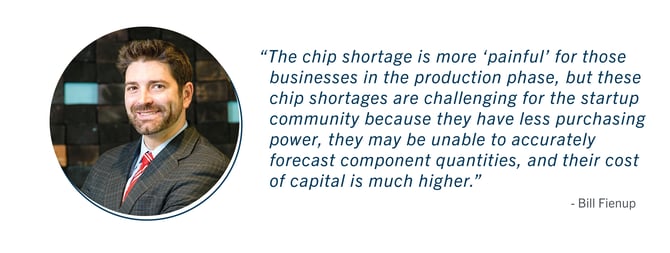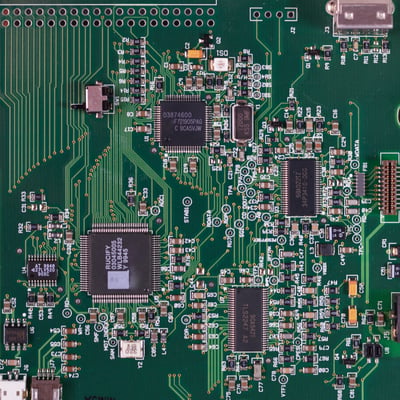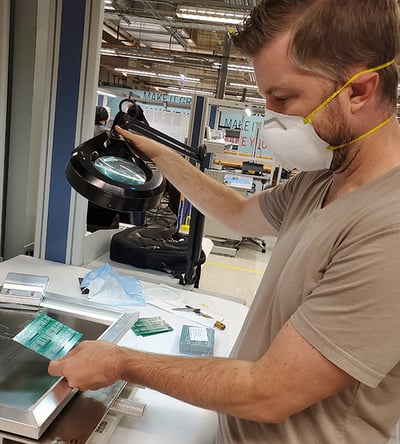
Over the last 30 years, the percentage of microchips manufactured in America went from 37% to 12% 1, and the impact of that decline in U.S. semiconductor manufacturing has been felt dramatically since the breakdown of global supply chains instigated by the COVID-19 pandemic. While the supply chain will eventually mend, its breakdown has intensified the spotlight on reshoring U.S. manufacturing.
Addressing chip shortages has naturally become an area of focus. Demand is high and will continue to rise, even as the ‘big three’ chip producers (Intel, Samsung, and TSMC) are strained to keep up. With excessive flooding in China, India, and Germany, wildfires in the western United States, and a deep freeze in Texas, natural disasters have continued to complicate logistics. Bottlenecks at major ports and breaks in cross-country transportation are also causing supply chain disruption 2. Until the many imbalances throughout the supply chain are corrected, the chip shortage continues to have major implications on manufacturing output.
The automotive and consumer electronics industries are in the headlines, but with more products and processes requiring chips, all industries are feeling the effects of the chip shortage. In mHUB’s corner of the world, hardtech innovators and startups are also being forced into alternatives. In this article, we’ll dive into how the chip shortage is impacting early-stage innovation and small- and medium-sized manufacturers (SMMs).

The chip shortage is more ‘painful’ for those businesses in the production phase, or those who are currently planning for the production phase. A large portion of mHUB member companies are still in the design phase of their hardtech development, so they are not as severely impacted. They can still acquire chipsets in smaller quantities from chip resellers or component distributors like Avnet, Digi-Key, Arrow, or Mouser. Still, these chip shortages are challenging for the startup community because they have less purchasing power, they may be unable to accurately forecast component quantities, and their cost of capital is much higher than a larger company.
For those trying to plan for production, there are real delays – specifically for many of the mHUB Hardtech Development small- and medium-size manufacturing (SMM) clients. In some cases, circuit boards have had to be redesigned using a chipset that will be available in the timeframe that the manufacturer requires. During this unique lapse in the supply chain, we are seeing component-level decisions being made based off future availability of these chips. Many manufacturers are purchasing and stockpiling test quantities themselves, so they do not have to redesign the board or re-program firmware based on a different sensor or processor.
The impact of needing to change a sensor due to availability is longer development time. Redeveloping a product to work with a different sensor involves re-programming the firmware for the specific sensor parameters, re-spinning the board, and then doing additional testing to ensure functionality. This translates into real delays for product launches and can stunt startups working to scale quickly.
How startups are functioning through and adapting to the chip shortage
Hardtech startups working through the product development process are still designing their innovative tech in small volumes, but the chip shortage drives the need for more upfront capital and motivates the placement of orders for components a year in advance. When we look at startups who are competing with larger manufacturers buying up the bulk of the existing supply, even from some of the smaller well-known component distributors, we see significant volatility in the availability of these chips. Items in stock can vary drastically on a second-by-second basis.
mHUB is fortunate to work with an extensive community, supplier network, and corporate partners, like Avnet, who released a private report on product lead times and supply trends. It is data like this and other information shared within the mHUB member community that helps support startups as they work to make accurate predictions. It is typically more difficult for startups to make 30-week predictions as accurately as an established manufacturer who has had a product in the field for a long time.

Mike Borish, from Borish Electronics Inc., works in the electronics lab at mHUB in Chicago.
Insights & Advice for Hardtech Startups
Go to Great Lengths to Validate Demand.
Assessing demand is even more important now with supply chain complications and constraints. Having to put up capital upfront, early, to secure semiconductors is so expensive for entrepreneurs – and this makes effective demand validation even more of a necessity. I would even go as far as to say that demand assessment is more important than the design of your product. This may seem a little counter-intuitive when the problem is a component shortage – but the advice is to understand your customer demand more because it will be more effective than redesigning your product.
Be Diligent in Forecasting.
Forecasting is one of the most important efforts startups need to undertake; especially as entrepreneurs may not always fully grasp the actual demand for their product. It’s crucial to go beyond talking to target customers to gauge the level of interest in the product being developed. One of the most reliable ways to validate demand for your product is to perform some customer experiments that would enable entrepreneurs to forecast their revenue with real data.
One experiment might be advertising for the product and seeing how many orders are placed or having pre-orders so actual demand for the product can be more accurately predicted. With that approach to testing, the startup can collect data on how buyers use their real dollars, enabling them to make truly informed decisions. Startups put a great deal of effort into designing and scaling their hardtech, so they want to know the market is going to be there when it comes time to release it to the public.
Try Production Planning to Raise the Capital Needed.
Hardtech startups need to plan for production and must define a plan for securing all the components needed for a production run. In most cases, the production planning is going to involve obtaining the capital required to secure production – so it’s better to obtain that capital early.
Change on the Horizon
While many people are forecasting that the chip shortage will last for the next 1 to 3 years, this chip shortage is temporary and it's possible the market may even over-correct. With the introduction of the U.S. Innovation and Competition Act of 2021 3, Congress is addressing the chip shortage with legislation and funding designed to inject $50+ Billion into American semiconductor manufacturing.
While this boost in domestic production of microchips will be too slow to address the current global chip shortage, turbulence can be navigated by working with regional networks uniquely positioned to support hardtech startups. mHUB is the leading independent hardtech and manufacturing innovation center, which exists to convene the entrepreneurial ecosystem around physical product innovation to ensure that the manufacturing industry continues to accelerate, grow and thrive. Having leveraged several federal grants to support startups and bolster job creation and economic development, member companies have launched more than 1,256 products, hired more than 2,153 employees, and raised nearly $702M in capital. By providing the right resources and access to manufacturing industry insiders, mHUB helps early-stage innovators go from prototype to product to sustainable business, driving a greater likelihood of success – even while navigating a chip shortage.
References:
1 – https://www.popsci.com/technology/global-chip-shortage/
3 - https://www.audacy.com/wbbm780/news/local/senate-working-to-fix-global-microchip-shortage






